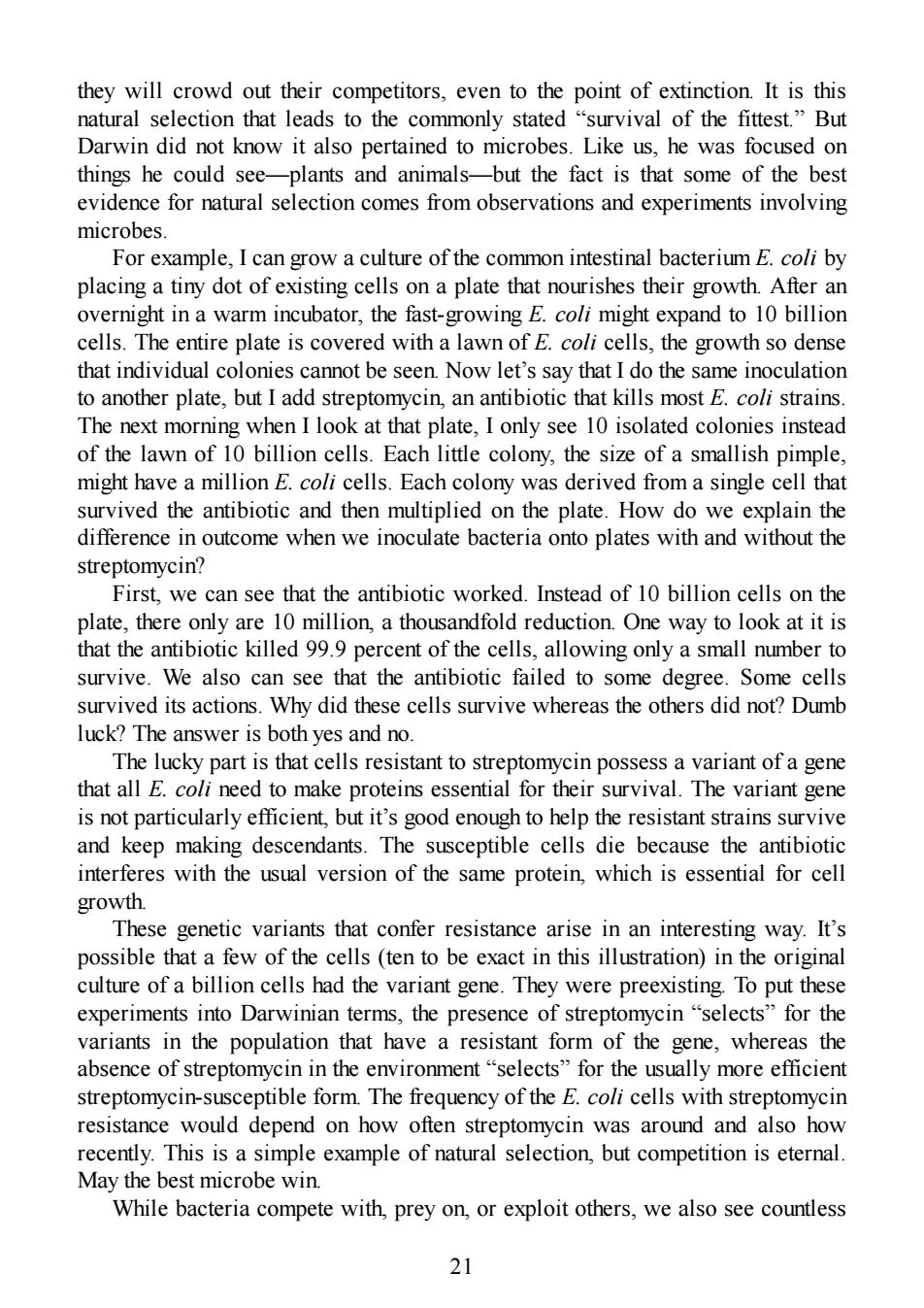
they will crowd out their competitors,even to the point of extinction.It is this natural selection that leads to the commonly stated I“survival of the fittest.”But Darwin did not know it also pertained to microbes.Like us,he was focused on things he could see-plants and animals-but the fact is that some of the best evidence for natural selection comes from observations and experiments involving microbes. For example,I can grow a culture of the common intestinal bacterium E.coli by placing a tiny dot of existing cells on a plate that nourishes their growth.After an overnight in a warm incubator,the fast-growing E.coli might expand to 10 billion cells.The entire plate is covered with a lawn of E.coli cells,the growth so dense that individual colonies cannot be seen.Now let's say that I do the same inoculation to another plate,but I add streptomycin,an antibiotic that kills most E.coli strains The next morning when I look at that plate,I only see 10 isolated colonies instead of the lawn of 10 billion cells.Each little colony,the size of a smallish pimple, might have a million E.coli cells.Each colony was derived from a single cell that survived the antibiotic and then multiplied on the plate.How do we explain the difference in outcome when we inoculate bacteria onto plates with and without the streptomycin? First,we can see that the antibiotic worked.Instead of 10 billion cells on the plate,there only are 10 million,a thousandfold reduction.One way to look at it is that the antibiotic killed 99.9 percent of the cells,allowing only a small number to survive.We also can see that the antibiotic failed to some degree.Some cells survived its actions.Why did these cells survive whereas the others did not?Dumb luck?The answer is both yes and no. The lucky part is that cells resistant to streptomycin possess a variant of a gene that all E.coli need to make proteins essential for their survival.The variant gene is not particularly efficient,but it's good enough to help the resistant strains survive and keep making descendants.The susceptible cells die because the antibiotic interferes with the usual version of the same protein,which is essential for cell growth. These genetic variants that confer resistance arise in an interesting way.It's possible that a few of the cells(ten to be exact in this illustration)in the original culture of a billion cells had the variant gene.They were preexisting To put these experiments into Darwinian terms,the presence of streptomycin "selects"for the variants in the population that have a resistant form of the gene,whereas the absence of streptomycin in the environment"selects"for the usually more efficient streptomycin-susceptible form.The frequency of the E.coli cells with streptomycin resistance would depend on how often streptomycin was around and also how recently.This is a simple example of natural selection,but competition is eternal May the best microbe win. While bacteria compete with,prey on,or exploit others,we also see countless 31
they will crowd out their competitors, even to the point of extinction. It is this natural selection that leads to the commonly stated “survival of the fittest.” But Darwin did not know it also pertained to microbes. Like us, he was focused on things he could see—plants and animals—but the fact is that some of the best evidence for natural selection comes from observations and experiments involving microbes. For example, I can grow a culture of the common intestinal bacterium E. coli by placing a tiny dot of existing cells on a plate that nourishes their growth. After an overnight in a warm incubator, the fast-growing E. coli might expand to 10 billion cells. The entire plate is covered with a lawn of E. coli cells, the growth so dense that individual colonies cannot be seen. Now let’s say that I do the same inoculation to another plate, but I add streptomycin, an antibiotic that kills most E. coli strains. The next morning when I look at that plate, I only see 10 isolated colonies instead of the lawn of 10 billion cells. Each little colony, the size of a smallish pimple, might have a million E. coli cells. Each colony was derived from a single cell that survived the antibiotic and then multiplied on the plate. How do we explain the difference in outcome when we inoculate bacteria onto plates with and without the streptomycin? First, we can see that the antibiotic worked. Instead of 10 billion cells on the plate, there only are 10 million, a thousandfold reduction. One way to look at it is that the antibiotic killed 99.9 percent of the cells, allowing only a small number to survive. We also can see that the antibiotic failed to some degree. Some cells survived its actions. Why did these cells survive whereas the others did not? Dumb luck? The answer is both yes and no. The lucky part is that cells resistant to streptomycin possess a variant of a gene that all E. coli need to make proteins essential for their survival. The variant gene is not particularly efficient, but it’s good enough to help the resistant strains survive and keep making descendants. The susceptible cells die because the antibiotic interferes with the usual version of the same protein, which is essential for cell growth. These genetic variants that confer resistance arise in an interesting way. It’s possible that a few of the cells (ten to be exact in this illustration) in the original culture of a billion cells had the variant gene. They were preexisting. To put these experiments into Darwinian terms, the presence of streptomycin “selects” for the variants in the population that have a resistant form of the gene, whereas the absence of streptomycin in the environment “selects” for the usually more efficient streptomycin-susceptible form. The frequency of the E. coli cells with streptomycin resistance would depend on how often streptomycin was around and also how recently. This is a simple example of natural selection, but competition is eternal. May the best microbe win. While bacteria compete with, prey on, or exploit others, we also see countless 21
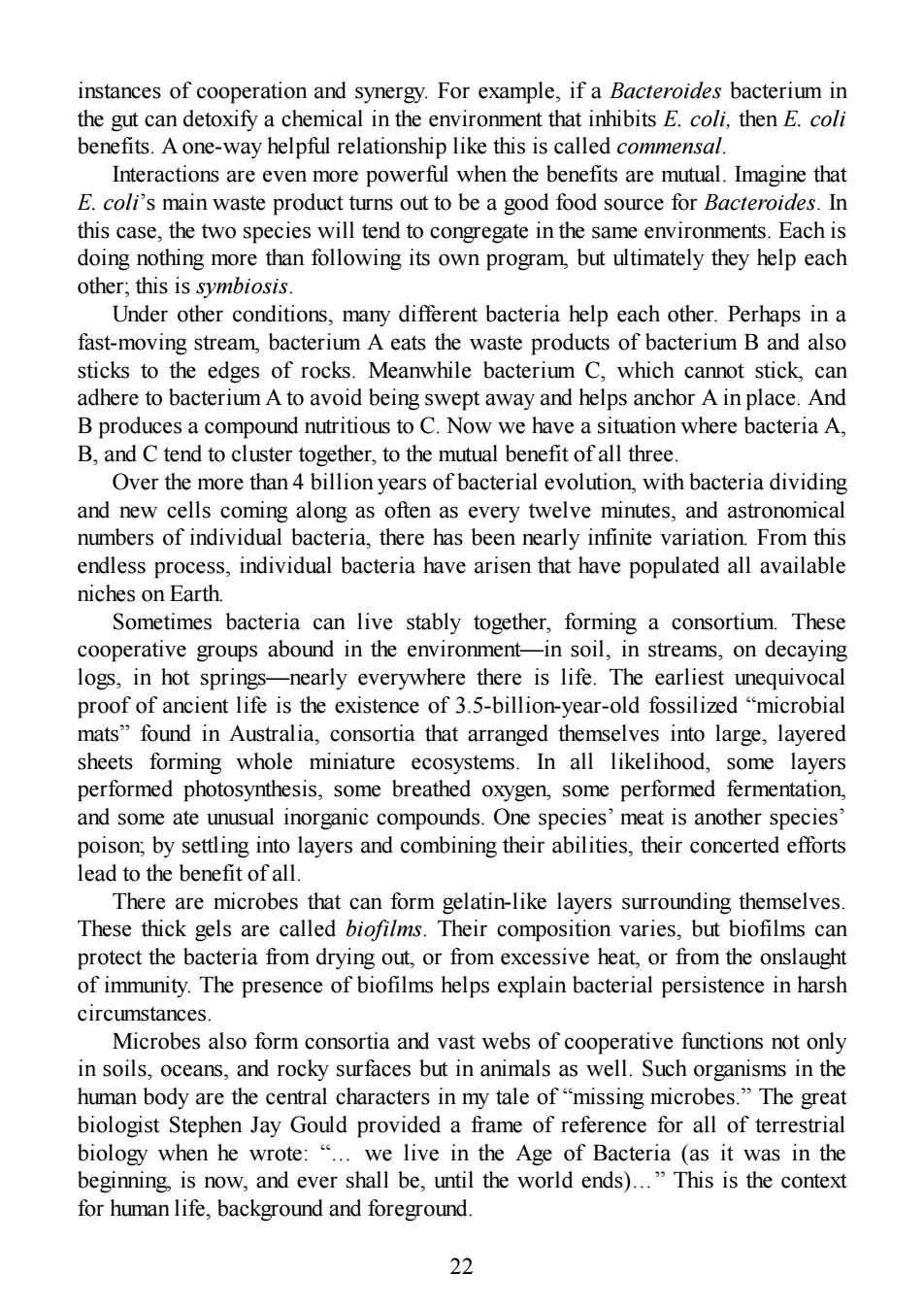
instances of cooperation and synergy.For example,if a Bacteroides bacterium in the gut can detoxify a chemical in the environment that inhibits E.coli,then E.coli benefits.A one-way helpful relationship like this is called commensal. Interactions are even more powerful when the benefits are mutual.Imagine that E.coli's main waste product turns out to be a good food source for Bacteroides.In this case,the two species will tend to congregate in the same environments.Each is doing nothing more than following its own program,but ultimately they help each other:this is svmbiosis Under other conditions,many different bacteria help each other.Perhaps in a fast-moving stream,bacterium A eats the waste products of bacterium B and also sticks to the edges of rocks.Meanwhile bacterium C,which cannot stick,can adhere to bacterium A to avoid being swept away and helps anchor A in place.And B produces a compound nutritious to C.Now we have a situation where bacteria A, B,and C tend to cluster together,to the mutual benefit of all three. Over the more than 4 billion years of bacterial evolution,with bacteria dividing and new cells coming along as often as every twelve minutes,and astronomical numbers of individual bacteria,there has been nearly infinite variation.From this endless process,individual bacteria have arisen that have populated all available niches on Earth Sometimes bacteria can live stably together,forming a consortium.These cooperative groups abound in the environment-in soil,in streams,on decaying logs.in hot springs -nearly everywhere there is life.The earliest unequivocal proof of ancient life is the existence of 3.5-billion-year-old fossilized"microbial mats"found in Australia,consortia that arranged themselves into large,layered sheets forming whole miniature ecosystems.In all likelihood,some layers performed photosynthesis,some breathed oxygen,some performed fermentation, and some ate unusual inorganic compounds.One species'meat is another species' poison;by settling into layers and combining their abilities,their concerted efforts lead to the benefit of all There are microbes that can form gelatin-like layers surrounding themselves These thick gels are called biofilms.Their composition varies,but biofilms can protect the bacteria from drying out,or from excessive heat,or from the onslaught of immunity.The presence of biofilms helps explain bacterial persistence in harsh circumstances Microbes also form consortia and vast webs of cooperative functions not only in soils,oceans,and rocky surfaces but in animals as well.Such organisms in the human body are the central characters in my tale of"missing microbes."The great biologist Stephen Jay Gould provided a frame of reference for all of terrestrial biology when he wrote: we live in the Age of Bacteria (as it was in the beginning is now,and ever shall be,until the world ends)..."This is the context for human life,background and foreground. 22
instances of cooperation and synergy. For example, if a Bacteroides bacterium in the gut can detoxify a chemical in the environment that inhibits E. coli, then E. coli benefits. A one-way helpful relationship like this is called commensal. Interactions are even more powerful when the benefits are mutual. Imagine that E. coli’s main waste product turns out to be a good food source for Bacteroides. In this case, the two species will tend to congregate in the same environments. Each is doing nothing more than following its own program, but ultimately they help each other; this is symbiosis. Under other conditions, many different bacteria help each other. Perhaps in a fast-moving stream, bacterium A eats the waste products of bacterium B and also sticks to the edges of rocks. Meanwhile bacterium C, which cannot stick, can adhere to bacterium A to avoid being swept away and helps anchor A in place. And B produces a compound nutritious to C. Now we have a situation where bacteria A, B, and C tend to cluster together, to the mutual benefit of all three. Over the more than 4 billion years of bacterial evolution, with bacteria dividing and new cells coming along as often as every twelve minutes, and astronomical numbers of individual bacteria, there has been nearly infinite variation. From this endless process, individual bacteria have arisen that have populated all available niches on Earth. Sometimes bacteria can live stably together, forming a consortium. These cooperative groups abound in the environment—in soil, in streams, on decaying logs, in hot springs—nearly everywhere there is life. The earliest unequivocal proof of ancient life is the existence of 3.5-billion-year-old fossilized “microbial mats” found in Australia, consortia that arranged themselves into large, layered sheets forming whole miniature ecosystems. In all likelihood, some layers performed photosynthesis, some breathed oxygen, some performed fermentation, and some ate unusual inorganic compounds. One species’ meat is another species’ poison; by settling into layers and combining their abilities, their concerted efforts lead to the benefit of all. There are microbes that can form gelatin-like layers surrounding themselves. These thick gels are called biofilms. Their composition varies, but biofilms can protect the bacteria from drying out, or from excessive heat, or from the onslaught of immunity. The presence of biofilms helps explain bacterial persistence in harsh circumstances. Microbes also form consortia and vast webs of cooperative functions not only in soils, oceans, and rocky surfaces but in animals as well. Such organisms in the human body are the central characters in my tale of “missing microbes.” The great biologist Stephen Jay Gould provided a frame of reference for all of terrestrial biology when he wrote: “… we live in the Age of Bacteria (as it was in the beginning, is now, and ever shall be, until the world ends)…” This is the context for human life, background and foreground. 22
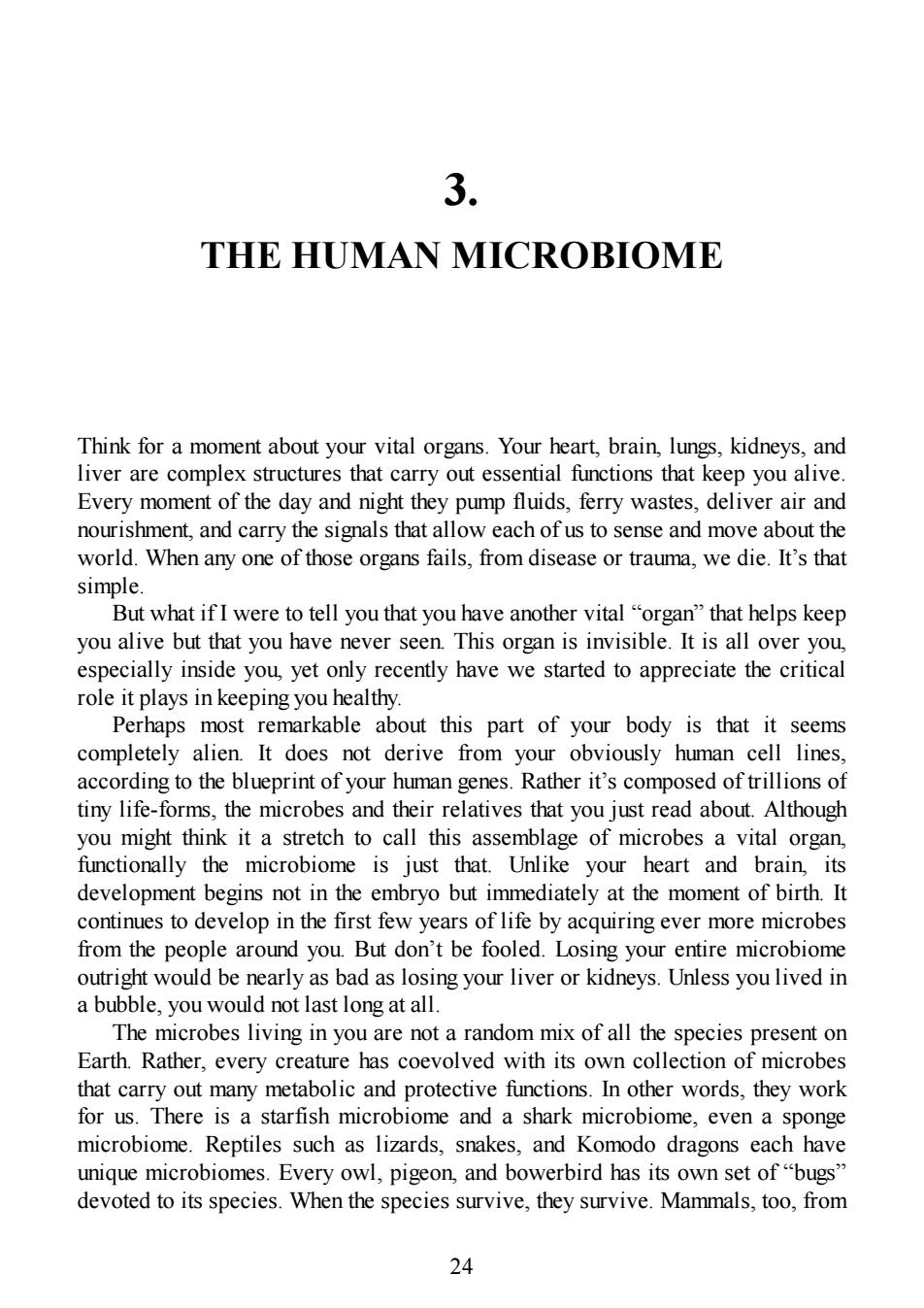
3. THE HUMAN MICROBIOME Think for a moment about your vital organs.Your heart,brain,lungs,kidneys,and liver are complex structures that carry out essential functions that keep you alive. Every moment of the day and night they pump fluids,ferry wastes,deliver air and nourishment,and carry the signals that allow each of us to sense and move about the world.When any one of those organs fails,from disease or trauma,we die.It's that simple. But what if I were to tell you that you have another vital "organ"that helps keep you alive but that you have never seen.This organ is invisible.It is all over you, especially inside you,yet only recently have we started to appreciate the critical role it plays in keeping you healthy. Perhaps most remarkable about this part of your body is that it seems completely alien.It does not derive from your obviously human cell lines, according to the blueprint of your human genes.Rather it's composed of trillions of tiny life-forms,the microbes and their relatives that you just read about.Although you might think it a stretch to call this assemblage of microbes a vital organ, functionally the microbiome is just that.Unlike your heart and brain,its development begins not in the embryo but immediately at the moment of birth.It continues to develop in the first few years of life by acquiring ever more microbes from the people around you.But don't be fooled.Losing your entire microbiome outright would be nearly as bad as losing your liver or kidneys.Unless you lived in a bubble,you would not last long at all. The microbes living in you are not a random mix of all the species present on Earth.Rather,every creature has coevolved with its own collection of microbes that carry out many metabolic and protective functions.In other words,they work for us.There is a starfish microbiome and a shark microbiome,even a sponge microbiome.Reptiles such as lizards,snakes,and Komodo dragons each have unique microbiomes.Every owl,pigeon,and bowerbird has its own set of"bugs" devoted to its species.When the species survive,they survive.Mammals,too,from 3
3. THE HUMAN MICROBIOME Think for a moment about your vital organs. Your heart, brain, lungs, kidneys, and liver are complex structures that carry out essential functions that keep you alive. Every moment of the day and night they pump fluids, ferry wastes, deliver air and nourishment, and carry the signals that allow each of us to sense and move about the world. When any one of those organs fails, from disease or trauma, we die. It’s that simple. But what if I were to tell you that you have another vital “organ” that helps keep you alive but that you have never seen. This organ is invisible. It is all over you, especially inside you, yet only recently have we started to appreciate the critical role it plays in keeping you healthy. Perhaps most remarkable about this part of your body is that it seems completely alien. It does not derive from your obviously human cell lines, according to the blueprint of your human genes. Rather it’s composed of trillions of tiny life-forms, the microbes and their relatives that you just read about. Although you might think it a stretch to call this assemblage of microbes a vital organ, functionally the microbiome is just that. Unlike your heart and brain, its development begins not in the embryo but immediately at the moment of birth. It continues to develop in the first few years of life by acquiring ever more microbes from the people around you. But don’t be fooled. Losing your entire microbiome outright would be nearly as bad as losing your liver or kidneys. Unless you lived in a bubble, you would not last long at all. The microbes living in you are not a random mix of all the species present on Earth. Rather, every creature has coevolved with its own collection of microbes that carry out many metabolic and protective functions. In other words, they work for us. There is a starfish microbiome and a shark microbiome, even a sponge microbiome. Reptiles such as lizards, snakes, and Komodo dragons each have unique microbiomes. Every owl, pigeon, and bowerbird has its own set of “bugs” devoted to its species. When the species survive, they survive. Mammals, too, from 24
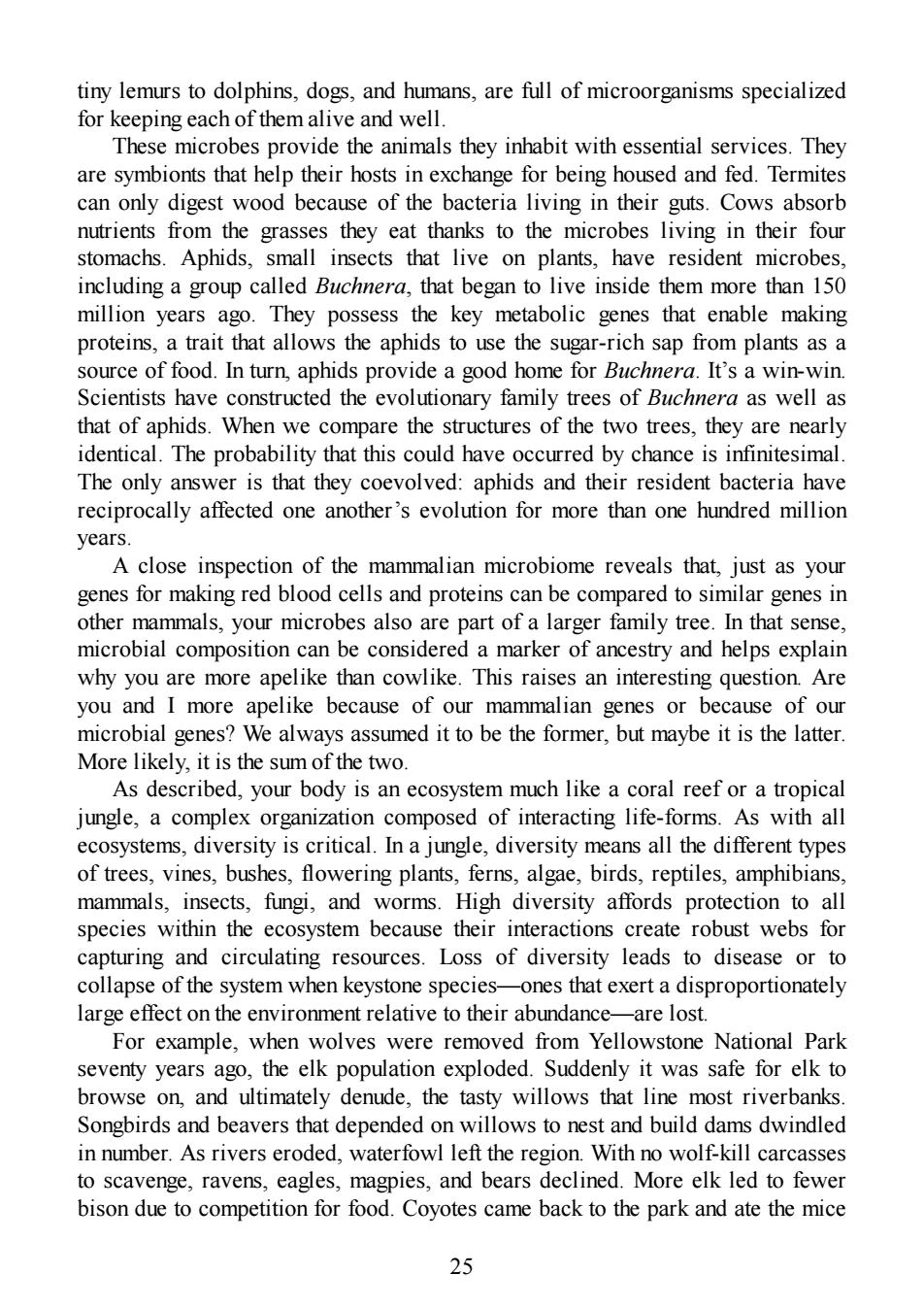
tiny lemurs to dolphins,dogs,and humans,are full of microorganisms specialized for keeping each of them alive and well These microbes provide the animals they inhabit with essential services.They are symbionts that help their hosts in exchange for being housed and fed.Termites can only digest wood because of the bacteria living in their guts.Cows absorb nutrients from the grasses they eat thanks to the microbes living in their four stomachs.Aphids,small insects that live on plants,have resident microbes, including a group called Buchnera,that began to live inside them more than 150 million years ago.They possess the key metabolic genes that enable making proteins,a trait that allows the aphids to use the sugar-rich sap from plants as a source of food.In turn,aphids provide a good home for Buchnera.It's a win-win. Scientists have constructed the evolutionary family trees of Buchnera as well as that of aphids.When we compare the structures of the two trees,they are nearly identical.The probability that this could have occurred by chance is infinitesimal The only answer is that they coevolved:aphids and their resident bacteria have reciprocally affected one another's evolution for more than one hundred million years A close inspection of the mammalian microbiome reveals that,just as your genes for making red blood cells and proteins can be compared to similar genes in other mammals,your microbes also are part of a larger family tree.In that sense, microbial composition can be considered a marker of ancestry and helps explain why you are more apelike than cowlike.This raises an interesting question.Are you and I more apelike because of our mammalian genes or because of our microbial genes?We always assumed it to be the former,but maybe it is the latter. More likely,it is the sum of the two. As described,your body is an ecosystem much like a coral reef or a tropical jungle,a complex organization composed of interacting life-forms. As with all ecosystems,diversity is critical.In a jungle,diversity means all the different types of trees,vines,bushes,flowering plants,ferns,algae,birds,reptiles,amphibians, mammals,insects,fungi,and worms.High diversity affords protection to all species within the ecosystem because their interactions create robust webs for capturing and circulating resources.Loss of diversity leads to disease or to collapse of the system when keystone species-ones that exert a disproportionately large effect on the environment relative to their abundance-are lost. For example,when wolves were removed from Yellowstone National Park seventy years ago,the elk population exploded.Suddenly it was safe for elk to browse on,and ultimately denude,the tasty willows that line most riverbanks Songbirds and beavers that depended on willows to nest and build dams dwindled in number.As rivers eroded,waterfowl left the region.With no wolf-kill carcasses to scavenge,ravens,eagles,magpies,and bears declined.More elk led to fewer bison due to competition for food.Coyotes came back to the park and ate the mice 25
tiny lemurs to dolphins, dogs, and humans, are full of microorganisms specialized for keeping each of them alive and well. These microbes provide the animals they inhabit with essential services. They are symbionts that help their hosts in exchange for being housed and fed. Termites can only digest wood because of the bacteria living in their guts. Cows absorb nutrients from the grasses they eat thanks to the microbes living in their four stomachs. Aphids, small insects that live on plants, have resident microbes, including a group called Buchnera, that began to live inside them more than 150 million years ago. They possess the key metabolic genes that enable making proteins, a trait that allows the aphids to use the sugar-rich sap from plants as a source of food. In turn, aphids provide a good home for Buchnera. It’s a win-win. Scientists have constructed the evolutionary family trees of Buchnera as well as that of aphids. When we compare the structures of the two trees, they are nearly identical. The probability that this could have occurred by chance is infinitesimal. The only answer is that they coevolved: aphids and their resident bacteria have reciprocally affected one another’s evolution for more than one hundred million years. A close inspection of the mammalian microbiome reveals that, just as your genes for making red blood cells and proteins can be compared to similar genes in other mammals, your microbes also are part of a larger family tree. In that sense, microbial composition can be considered a marker of ancestry and helps explain why you are more apelike than cowlike. This raises an interesting question. Are you and I more apelike because of our mammalian genes or because of our microbial genes? We always assumed it to be the former, but maybe it is the latter. More likely, it is the sum of the two. As described, your body is an ecosystem much like a coral reef or a tropical jungle, a complex organization composed of interacting life-forms. As with all ecosystems, diversity is critical. In a jungle, diversity means all the different types of trees, vines, bushes, flowering plants, ferns, algae, birds, reptiles, amphibians, mammals, insects, fungi, and worms. High diversity affords protection to all species within the ecosystem because their interactions create robust webs for capturing and circulating resources. Loss of diversity leads to disease or to collapse of the system when keystone species—ones that exert a disproportionately large effect on the environment relative to their abundance—are lost. For example, when wolves were removed from Yellowstone National Park seventy years ago, the elk population exploded. Suddenly it was safe for elk to browse on, and ultimately denude, the tasty willows that line most riverbanks. Songbirds and beavers that depended on willows to nest and build dams dwindled in number. As rivers eroded, waterfowl left the region. With no wolf-kill carcasses to scavenge, ravens, eagles, magpies, and bears declined. More elk led to fewer bison due to competition for food. Coyotes came back to the park and ate the mice 25
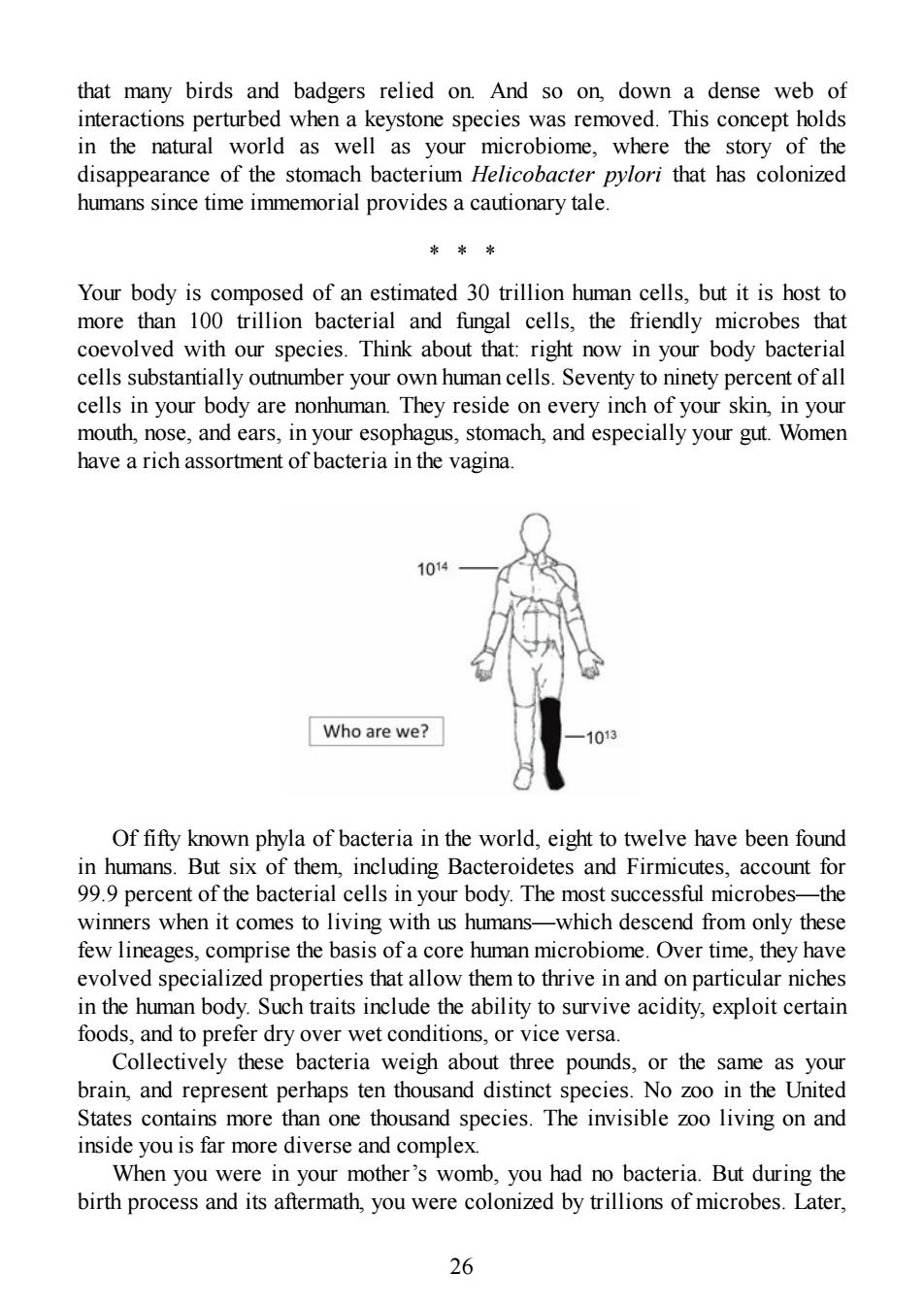
that many birds and badgers relied on.And so on,down a dense web of interactions perturbed when a keystone species was removed.This concept holds in the natural world as well as your microbiome,where the story of the disappearance of the stomach bacterium Helicobacter pylori that has colonized humans since time immemorial provides a cautionary tale. Your body is composed of an estimated 30 trillion human cells,but it is host to more than 100 trillion bacterial and fungal cells,the friendly microbes that coevolved with our species.Think about that:right now in your body bacterial cells substantially outnumber your own human cells.Seventy to ninety percent of all cells in your body are nonhuman.They reside on every inch of your skin,in your mouth,nose,and ears,in your esophagus,stomach,and especially your gut.Women have a rich assortment of bacteria in the vagina. 1014 Who are we? 101 Of fifty known phyla of bacteria in the world,eight to twelve have been found in humans.But six of them,including Bacteroidetes and Firmicutes,account for 99.9 percent of the bacterial cells in your body.The most successful microbes-the winners when it comes to living with us humans-which descend from only these few lineages,comprise the basis ofa core human microbiome.Over time,they have evolved specialized properties that allow them to thrive in and on particular niches in the human body.Such traits include the ability to survive acidity,exploit certain foods,and to prefer dry over wet conditions,or vice versa. Collectively these bacteria weigh about three pounds,or the same as your brain,and represent perhaps ten thousand distinct species.No zoo in the United States contains more than one thousand species.The invisible zoo living on and inside you is far more diverse and complex. When you were in your mother's womb,you had no bacteria.But during the birth process and its aftermath,you were colonized by trillions of microbes.Later. 26
that many birds and badgers relied on. And so on, down a dense web of interactions perturbed when a keystone species was removed. This concept holds in the natural world as well as your microbiome, where the story of the disappearance of the stomach bacterium Helicobacter pylori that has colonized humans since time immemorial provides a cautionary tale. * * * Your body is composed of an estimated 30 trillion human cells, but it is host to more than 100 trillion bacterial and fungal cells, the friendly microbes that coevolved with our species. Think about that: right now in your body bacterial cells substantially outnumber your own human cells. Seventy to ninety percent of all cells in your body are nonhuman. They reside on every inch of your skin, in your mouth, nose, and ears, in your esophagus, stomach, and especially your gut. Women have a rich assortment of bacteria in the vagina. Of fifty known phyla of bacteria in the world, eight to twelve have been found in humans. But six of them, including Bacteroidetes and Firmicutes, account for 99.9 percent of the bacterial cells in your body. The most successful microbes—the winners when it comes to living with us humans—which descend from only these few lineages, comprise the basis of a core human microbiome. Over time, they have evolved specialized properties that allow them to thrive in and on particular niches in the human body. Such traits include the ability to survive acidity, exploit certain foods, and to prefer dry over wet conditions, or vice versa. Collectively these bacteria weigh about three pounds, or the same as your brain, and represent perhaps ten thousand distinct species. No zoo in the United States contains more than one thousand species. The invisible zoo living on and inside you is far more diverse and complex. When you were in your mother’s womb, you had no bacteria. But during the birth process and its aftermath, you were colonized by trillions of microbes. Later, 26